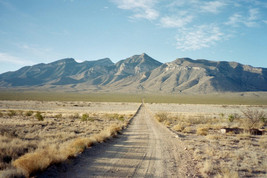Soil type is important to consider when selecting the best drilling method for your next project. Using the best drilling method for site conditions saves time and money for your field investigation. In the past, we discussed various soil types encountered in Texas. Today we will focus on soil types in the southeastern region of New Mexico.
How Does Soil Form?
Soil forms as a result of chemical and physical weathering processes that break down exposed geologic materials. Rainfall, temperature, and wind erosion also play a part in soil development. For example, soil developed from volcanic rocks may be more granular in an arid climate rather than clayey in a more temperate clime. The texture and composition of soil that forms is directly related to the underlying geology.
Where underlying rocks are granite, coarse grained sediments or sedimentary rocks (e.g., stream sand and gravel, sandstone), soil will be sandy and gravelly. On limestone, shale or volcanic rocks that are either fine-grained or chemically weathered, soil will be clayey.
What Are The Different Geologic Regions in New Mexico?
Geology in southeastern New Mexico, generally consisting of Chaves, Eddy and Lea Counties, is varied and complex. This area is called the Delaware Basin, the northwestern extent of the Permian Basin of oil producing fame. Bedrock is mainly limestone, with interbedded sandstone and shale.
To the east, bedrock formations include red beds and gypsum. Overlying the Permian Basin geologic formations in eastern Lea County is the western extent of the High Plains. This consists of younger Tertiary to Quaternary sedimentary rocks consisting of sediments shed from the Rocky Mountains farther east. The Ogallala Formation is one of the main Tertiary sedimentary formations.
What Soil Types Are Present in Southeastern New Mexico?
Varied soil types are present in southeastern New Mexico and can be clayey to sandy, cobbly, calcareous or gypseous. Clayey soil develops on siltstone, shale and red beds present in the eastern part of the area. Sandy and cobbly soil develops on alluvium associated with streams that drain limestone, sandstone or gypsum bedrock highlands, on colluvium derived from these rocks, or where these rocks are exposed in slopes.
Indurated caliche is common in many areas where limestone bedrock or resultant alluvium is present. Caliche forms when calcium carbonate is leached from surface soil and rock (limestone) and precipitated in the subsurface as hard granules or distinct layers. Caliche can be present in the subsurface below one to two feet depth. Gypseous soil (mostly gypsum) is present in central New Mexico where Paleozoic gypsum formations are present.
What Types of Drilling Methods Should Be Used in New Mexico?
Push probe drilling may be appropriate for southeastern New Mexico where shallow subsurface conditions are sandy or clayey and do not contain gravelly soil or indurated caliche layers. Auger drilling can be used wherever push probe drilling is feasible and potentially in some areas where caliche or gravelly soil is present.
When gravelly soil, caliche layers or bedrock conditions are present in the shallow subsurface, then other rotary drilling methods may be a better choice.
If you are pursuing an environmental drilling project in southeastern New Mexico, contact the drilling experts at Talon/LPE. Serving the Texas, Oklahoma and New Mexico regions, Talon / LPE has experience dealing with a variety of soil types and geologic formations.

